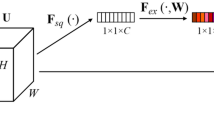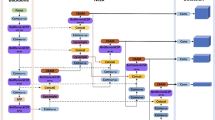Abstract
Safety harness plays an essential role in protecting the workers in high-altitude operations from falls from heights. Automatic detection of safety harness wearing is significant for safety management. To deal with the inherent problems of the existing two-stage detection method for safety harnesses, a novel one-stage detection framework is designed by incorporating several promising modules into a YOLO network, which is end-to-end trained. Here, the dilated convolution module and the depth-wise separable convolution module are subsequently incorporated to improve the overall receptive fields of feature maps and to reduce the amount of calculation, respectively. An attention proposal sub-network (APN) is introduced for fine-grained feature learning. To improve the convergence of the proposed framework, a novel loss function is designed by adding a penalty term into the loss function named complete intersection over union (CIoU). Also, to facilitate the study, a new and publicly available dataset for safety harness wearing detection is constructed, which consists of 2617 images including 8163 safety harness examples. Experimental results demonstrate that the proposed framework can perform an excellent task for safety harness wearing detection with 80.25% mAP at a reasonable speed of 29.18 FPS, especially for small instances.




Similar content being viewed by others
References
Grcevich, L.O., Jabaay, M.J., Leicht, B.T., Lyons, J.: Initial resuscitation of a multisystem trauma patient following a fall from height: a complete simulation scenario for medical students. Cureus 13(1), e13013 (2021). https://doi.org/10.7759/cureus.13013
Robson, L.S., Lee, H., Amick Iii, B.C., Landsman, V., Smith, P.M., Mustard, C.A.: Preventing fall-from-height injuries in construction: effectiveness of a regulatory training standard. J. Safety Res. 74, 271–278 (2020). https://doi.org/10.1016/j.jsr.2020.06.007
Nadhim, E.A., Hon, C., Xia, B., Stewart, I., Fang, D.: Falls from height in the construction industry: a critical review of the scientific literature. Int. J. Environ. Res. Public Health 13(7), 638 (2016). https://doi.org/10.3390/ijerph13070638
Gómez-de-Gabriel, J.M., Fernández-Madrigal, J.A., López-Arquillos, A., Rubio-Romero, J.C.: Monitoring harness use in construction with BLE beacons. Measurement 131, 329–340 (2019). https://doi.org/10.1016/j.measurement.2018.07.093
Fang, W., Ding, L., Luo, H., Love, P.E.: Falls from heights: A computer vision-based approach for safety harness detection. Autom. Constr. 91, 53–61 (2018). https://doi.org/10.1016/j.autcon.2018.02.018
Li, F., Cai, N., Deng, X., Li, J., Lin, J., Wang, H.: Serial number inspection for ceramic membranes via an end-to-end photometric-induced convolutional neural network framework. J. Intell. Manuf. (2021). https://doi.org/10.1007/s10845-020-01730-7
Zhou, Y., Liu, T.: Computer vision-based crack detection and measurement on concrete structure. J. Tongji Univer. (Nat. Sci.) 47(9), 1277–1285 (2019). https://doi.org/10.11908/j.issn.0253-374x.2019.09.007
Abdurakipov, S., Tokarev, M., Butakov, E., Dulin, V.: Application of computer vision and neural network analysis to study the structure and dynamics of turbulent jets. J. Phys.: Confer. Ser. 1421(1), 012018 (2019). https://doi.org/10.1088/1742-6596/1421/1/012018
Arinichev, I.V., Polyanskikh, S.V., Volkova, G.V., Arinicheva, I.V.: rice fungal diseases recognition using modern computer vision techniques. Int. J. Fuzzy Log. Intell. Syst. 21(1), 1–11 (2021)
Patel, R., Patel, S.: A comprehensive study of applying convolutional neural network for computer vision. Int. J. Adv. Sci. Technol. 6, 2161–2174 (2020)
Bochkovskiy, A., Wang, C.Y., Liao, H.Y.M.: YOLOv4: optimal speed and accuracy of object detection (2020). https://arxiv.org/abs/2004.10934
Yu, F., Koltun, V., Funkhouser, T.: Dilated residual networks. In: Proceedings of IEEE Conference on Computer Vision and Pattern Recognition (CVPR), pp. 472–480 (2017). https://doi.org/10.1109/CVPR.2017.75
Howard, A.G., Zhu, M., Chen, B., Kalenichenko, D., Wang, W., Weyand, T., Andreetto, M., Adam, H.: MobileNets: efficient convolutional neural networks for mobile vision applications (2017). https://arxiv.org/abs/1704.04861
Fu, J., Zheng, H., Mei, T.: Look closer to see better: recurrent attention convolutional neural network for fine-grained image recognition. In: Proceedings of IEEE Conference on Computer Vision and Pattern Recognition (CVPR), pp. 4438–4446 (2017). https://doi.org/10.1109/CVPR.2017.476
Zheng, Z., Wang, P., Liu, W., Li, J., Ye, R., Ren, D.: Distance-IoU loss: faster and better learning for bounding box regression. In: Proceedings of the AAAI Conference on Artificial Intelligence, vol. 34, no. 07, pp. 12993–13000 (2020). https://doi.org/10.1609/aaai.v34i07.6999
He, K., Zhang, X., Ren, S.: Spatial pyramid pooling in deep convolutional networks for visual recognition. IEEE Trans. Pattern Anal. Mach. Intell. 37(9), 1904–1916 (2014). https://doi.org/10.1109/TPAMI.2015.2389824
Lin, T.Y., Dollár, P., Girshick, R., He, K., Hariharan, B., Belongie, S.: Feature pyramid networks for object detection. In: Proceedings of IEEE Conference on Computer Vision and Pattern Recognition (CVPR), pp. 936–944 (2017). https://doi.org/10.1109/CVPR.2017.106
Liu, S., Qi, L., Qin, H., Shi, J., Jia, J.: Path aggregation network for instance segmentation. In: Proceedings of the IEEE Conference on Computer Vision and Pattern Recognition (CVPR), pp. 8759–8768 (2018). https://doi.org/10.1109/CVPR.2018.00913
Liu, W., Anguelov, D., Erhan, D., Szegedy, C., Reed, S., Fu, C.Y., Berg, A.C.: SSD: single shot multibox detector. In: Proceedings of European Conference on Computer Vision (ECCV), pp. 21–37 (2016). https://doi.org/10.1007/978-3-319-46448-0_2
Acknowledgements
This work was in part supported by the National Natural Science Foundation of China (Nos. 62171142 and 61901123), and the Research Fund for Colleges and Universities in Huizhou (No. 2019HZKY003).
Author information
Authors and Affiliations
Corresponding author
Ethics declarations
Conflict of interest
The authors declare that they have no conflict of interest.
Additional information
Publisher's Note
Springer Nature remains neutral with regard to jurisdictional claims in published maps and institutional affiliations.
Rights and permissions
About this article
Cite this article
Wu, L., Cai, N., Liu, Z. et al. A one-stage deep learning framework for automatic detection of safety harnesses in high-altitude operations. SIViP 17, 75–82 (2023). https://doi.org/10.1007/s11760-022-02205-3
Received:
Revised:
Accepted:
Published:
Issue Date:
DOI: https://doi.org/10.1007/s11760-022-02205-3




